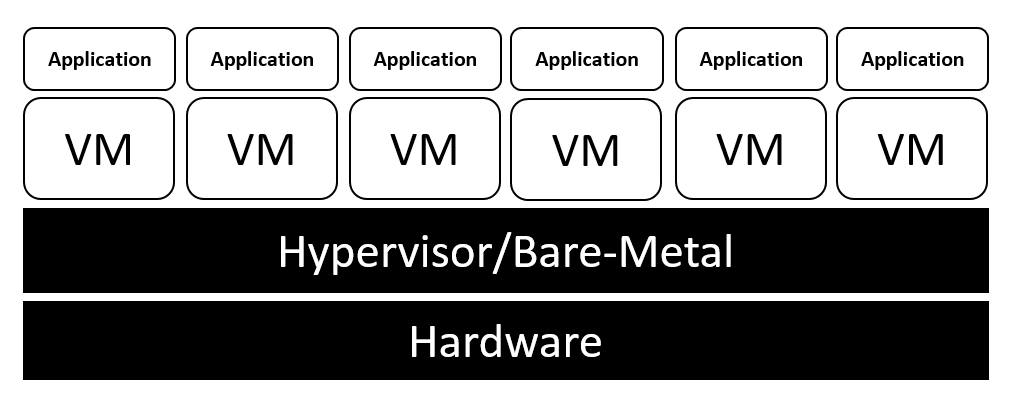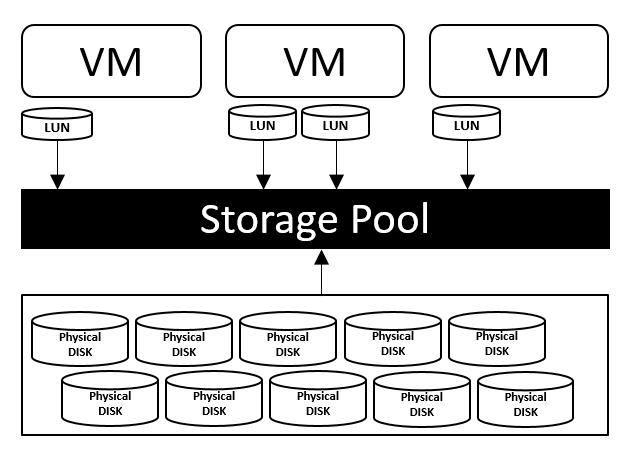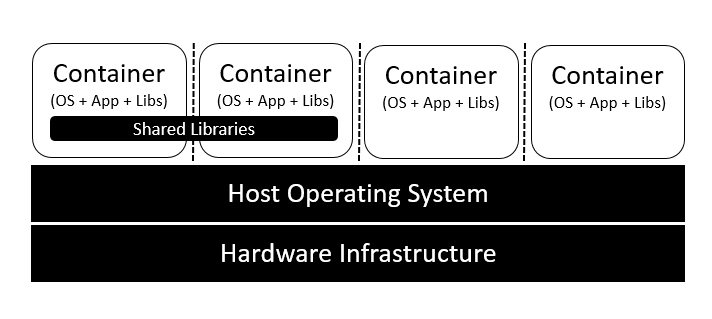Depending on how the underlying infrastructure is abstracted away from the users and the isolation level, various virtualization technologies have evolved. The following sections discuss a few virtualization levels in brief, which eventually lead to containerization.
During the pre-virtualization era, a physical machine was considered a singleton entity that could host one operation system and could contain more than one application. Enterprises that run highly critical businesses or multitenant environments need isolation between applications. This limits from using one server for many applications. Hardware virtualization or VM virtualization helped to scale out single physical servers as they host multiple VMs within a single server where each VM can run in complete isolation. Each VM's CPU and memory needs can be configured as per the application's demand.
A discrete software unit called hypervisor or Virtual Machine Manager (VMM) runs on top of virtualized hardware and facilitates server virtualization. Modern cloud platforms, both public and private, are the best examples of hardware virtualization. Each physical server runs an operation system called host OS, which runs multiple VMs each with their own OS called guest OS. The underlying memory and CPU of the host OS is shared across the VMs depending on how the VMs are configured while creating. Server virtualization also enables hybrid computing, which means the guest OS can be of any type, for example, a machine running Windows with Hyper-V role enabled can host VMs running Linux and Windows OSes (for example Windows 10 and Windows 8.1) or even another Windows Server OS. Some examples of server virtualization are VMware, Citrix XenServer, and MS Hyper-V.
In a nutshell, this is what platform virtualization looks like:

Storage virtualization refers to pooling of storage resources to provide a single large storage space, which can be managed from a single console. Storage virtualization offers administrative benefits such as managing backups, archiving, on demand storage allocation, and so on.
For example, Windows Azure VMs by default contain two disk drives for storage, but on demand we can add any number of disk drives to the VM within minutes (limited to the VM tier). This allows instant scalability and better utilization since we are only paying for what we use and expand/shrink as per demand.
This is what storage virtualization looks like:

Network virtualization is the ability to create and manage a logical network of compute, storage, or other network resources. The components of a virtual network can be remotely located in the same or different physical networks across different geographical locations. Virtual networks help us create custom address spaces, logical subnets, custom network security groups for configuring restricted access to a group of nodes, custom IP configuration (few applications demand static IPs or IPs within a specific range), domain defined traffic routing, and so on.
Most of the LOB applications demand logical separation between business components for enhanced security, isolation, and scalability needs. Network virtualization helps build the isolation configuring subnet level security policies, restrict access to logical subnets or nodes using access control list (ACL), and restrict inbound/outbound traffic using custom routing without running a physical network. Public cloud vendors provide network virtualization on pay per use basis for small to medium scale business who cannot afford running a private IT infrastructure. For example, Microsoft Azure allows you to create a virtual network with network security boundaries, secure VPN tunnel to connect to your personal laptops, or on-premise infrastructure, high bandwidth private channels, and so on using pay-per-use pricing. You can run your applications on cloud with tight security among nodes using logical separation without even investing on any network devices.
The topic of this book is associated with OS virtualization. OS virtualization enables the kernel to be shared across multiple processes inside a single VM with isolation. OS virtualization is also called user-mode or user-space virtualization as it is one level up from the kernel. Individual user-space instances are called containers. The kernel provides all the features for resource management across containers.
This is highly helpful while consolidating a set of services spread across multiple servers into a single server. Few benefits of OS virtualization are high security due to reduced surface of contact for a breach or viruses, better resource management, easy migration of applications or services across hosts, and also instant and dynamic load balancing. OS virtualization does not require any hardware support, so it is easy to implement than other technologies. The most recent implementations of OS virtualization are Linux LXC, Docker, and Windows Server Containers.This is what OS virtualization looks like:




